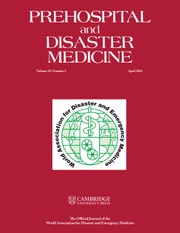No CrossRef data available.
Article contents
Comparison of Outcome Tools Used to Test Mass-Casualty Algorithms in the Pediatric Population
Published online by Cambridge University Press: 06 October 2021
Abstract
Mass-casualty incident (MCI) algorithms are used to sort large numbers of patients rapidly into four basic categories based on severity. To date, there is no consensus on the best method to test the accuracy of an MCI algorithm in the pediatric population, nor on the agreement between different tools designed for this purpose.
This study is to compare agreement between the Criteria Outcomes Tool (COT) to previously published outcomes tools in assessing the triage category applied to a simulated set of pediatric MCI patients.
An MCI triage category (black, red, yellow, and green) was applied to patients from a pre-collected retrospective cohort of pediatric patients under 14 years of age brought in as a trauma activation to a Level I trauma center from July 2010 through November 2013 using each of the following outcome measures: COT, modified Baxt score, modified Baxt combined with mortality and/or length-of-stay (LOS), ambulatory status, mortality alone, and Injury Severity Score (ISS). Descriptive statistics were applied to determine agreement between tools.
A total of 247 patients were included, ranging from 25 days to 13 years of age. The outcome of mortality had 100% agreement with the COT black. The “modified Baxt positive and alive” outcome had the highest agreement with COT red (65%). All yellow outcomes had 47%-53% agreement with COT yellow. “Modified Baxt negative and <24 hours LOS” had the highest agreement with the COT green at 89%.
Assessment of algorithms for triaging pediatric MCI patients is complicated by the lack of a gold standard outcome tool and variability between existing measures.
Keywords
Information
- Type
- Original Research
- Information
- Copyright
- © The Author(s), 2021. Published by Cambridge University Press on behalf of the World Association for Disaster and Emergency Medicine


